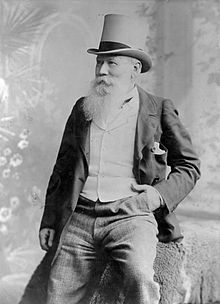
Summary
John Willis & Sons of London, also called the Jock Willis Shipping Line, was a nineteenth-century London-based ship-owning firm. It owned a number of clippers including the historic tea clipper Cutty Sark.[2]: 196
 | |
| Company type | Private company |
|---|---|
| Industry | Shipping |
| Founded | 1830[1] |
| Founder | John Willis, Senior |
| Defunct | 1899[1] |
| Headquarters | London, Great Britain |
Key people | John Willis, Senior John Willis, Junior |
| Products | tea, wool |

Company history and its people edit
The company was founded in London by John 'Jock' Willis (1791–1862), a ship captain (nicknamed 'Old Stormy Willis').[3] Jock Willis had joined ships sailing along the British coast after having run away from his home at Eyemouth, Berwickshire, when he was 14 years old.[4] During one of his sailing voyages to London, he found employment at a pub frequented by seafarers in the New India Dock (now Canary Wharf). He saved the money earned there, supplemented by money earned by repairing seafarers' sea shanty musical instruments.[4] He returned to sail on the West Indiamen as a second and Chief Mate.[5]
Willis married Janet Dunbar on 23 July 1815,[4] and the couple had nine children – six sons and three daughters – of whom the eldest was also named John. In 1826, he started his own ship owning company, registered in London.[4]
The younger Jock Willis (1817–1899), himself a ship master, took over his father's firm of ship owners. Also known as 'White Hat Willis', it was during his time that the company built and owned clippers like Cutty Sark.[6] The other sons, too, joined the company in various capacities – either sailing on their ships or working in their offices.
Trade edit
Their ships focused on the tea trade between China, the far east and United Kingdom and the wool trade with Australia.[4]
Ships edit
The first vessel purchased by John Willis was the 253-ton Sunderland-built barque Demarara Planter in 1830,[1] which sailed to the West Indies. Many of the ships later built by the firm were named after places in Willis' native county of Berwickshire.[1] Company ships included:
- Demerara Planter (1830)[7]
- Janet Willis (1835)
- John Willis (1839)
- Whampoa (1842)
- Borderer (1845)
- Saint Abbs (1848)[1]
- Janet Willis (1850)
- Merse (1853)
- Berwickshire (1855)
- Lammermuir (1856)
- Lauderdale (1858)
- Laurel (1861)
- Albuera (1862)
- Whiteadder (1862)[4][2]: 132
- The Tweed (acquired 1863; launched 1854 as the Punjaub)
- Lammermuir (1864)[4]
- Zenobia (1867)
- Borderer (1868)
- Dharwar (1868)
- Coldinghame (1869)[1]
- Cutty Sark (1869)[8]
- Blackadder (1870)[4]
- Hallowe'en (1872)
- Coldstream (1875)[1]
- Jumna (1875)
- Fantasie (1877)
- Sumatra (1878)
- Taitsing (1880)
Motto edit
showing the Willis logo
The company's motto, 'Where there's a will is a way', was a pun on the family name, and was displayed on the stern of all Willis ships.[9][10]
1899 – the end edit
The company was dissolved in 1899, with the sale of the Cutty Sark.[1]
References edit
- ^ a b c d e f g h Crosse, John (22 March 2013). "John Willis & Sons (1830-1899)". The Mariner's Mirror. 58 (4): 397–402. doi:10.1080/00253359.1972.10658681.
- ^ a b MacGregor, David R. (1983). The Tea Clippers, Their History and Development 1833-1875. Conway Maritime Press Limited. ISBN 0-85177-256-0.
- ^ Spectre, Peter (2005). A Mariner's Miscellany. Sheridan House. p. 21. ISBN 978-1574091953.
- ^ a b c d e f g h Holden, Walter V.; McGiveron, Joan. John Willis and the "Cutty Sark" Tea Clipper. Eyemouth, United Kingdom: The Family history forum.
- ^ Shewan, Andrew (31 December 1996). The Great Days of Sail: Reminiscences of a Tea-clipper Captain (New Edition – 1996 ed.). United Kingdom: Conway Classics - Conway Maritime Press Ltd. ISBN 978-0851776996.
- ^ "History of the Cutty Sark". rmg.co.uk. National Maritime Museum. Archived from the original on 6 June 2014. Retrieved 3 June 2014.
- ^ "Oil painting - Ship Portrait - Demerara Planter". Art UK. Retrieved 3 June 2014.
- ^ Lubbock, Basil (1925). The log of the "Cutty Sark". Glasgow: J.Brown & Sons. Retrieved 3 June 2014.
- ^ Cruising World - Nautical History (Jan - Oct 2000 ed.).
- ^ Bold, J.; Bradbeer, Charlotte; Merwe, P. Van der (31 May 1999). Maritime Greenwich: A world heritage site : A guide. Great Britain: National Maritime Museum and Collins & Browne. p. 23. ISBN 978-0948065286.


